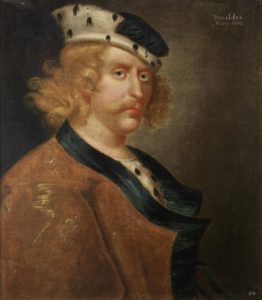
For most of us, our first contact with Donald Bane (or Donalbane) comes with the play Macbeth. After poor King Duncan was killed in his bed, his heirs feared assassination and fled the scene; Prince Malcolm slipped away to England and Donald Bane went to Ireland. And this is the last we see of Donald Bane in the play. Who was he and what happened to him?
There seems to be no historic trail from the death of his father until 1093, when he usurped the throne of Scotland. It is said that in 1060 he became Mormaer of Gowrie (modern Perthshire), yet it is assumed he lived in the Western Isles and possibly Ireland. I’ve found reference to his exile there but no explanation, so we are left to fill in the blanks. What we do know is that he aligned himself with the pro-Gaelic party in Scotland, which was in opposition to Malcolm and Margaret’s attempt to suppress the Celtic Church in favor of Catholicism.
It wasn’t until 1093 that Donald Bane made his move. Somehow he knew about Malcolm’s last campaign into Northumbria, because we find that in the King’s absence he laid siege to Edinburgh castle. He knew that Queen Margaret was in residence with her younger sons, and intended to acquire them as hostages. If you’ve ever been to Edinburgh, you know that the castle is perched high on a rugged cliff, so his army would have encamped on the other side.

Assuming the cliff was impassible was his big mistake. As depicted in my novel, HEIR TO A PROPHECY, the ailing Margaret died within minutes of hearing that the king and her eldest son had been slain. Her surviving sons and servants devised a litter and lowered the queen’s body all the way down the cliff, protected by a mysterious white mist. They ferried Margaret across the river to Dunfermline so she could get a proper burial.
That didn’t stop Donald Bane. According to the ancient tanist system of Scottish inheritance, the younger brother of a king could inherit the throne before the son if matters were so arranged. Donald was the younger brother of Malcolm III, and was duly elected to the empty throne. However, he only reigned initially for six months, until Malcolm’s first son Duncan (by his wife Ingeborg) invaded with an army backed by King William Rufus of England.
Alas for Duncan, his reign only lasted six months. Donald Bane joined forces with Duncan’s half-brother Edmund (son of Margaret) and killed the hapless king, reigning jointly with Edmund in his stead. Donald oversaw the north (Scotia) and Edmund ruled the south (Lothian). This lasted for three years.
But William Rufus did not condone an anti-Norman king on the Scottish throne. Edgar, probably the second son of Malcolm and Margaret, had taken refuge in the English court, and Rufus sent him north with an army to dethrone Donald Bane in 1097. The victor was crowned and known as Edgar the Peaceable (because of his submission to William Rufus). Apparently the remorseful Edmund was forgiven and later became a monk, thus removing himself from the succession.
Donald Bane was not so lucky. Edgar threw him into prison at Rescobie in Angus and had his eyes put out for good measure. Donald died within two years, and was eventually buried at Iona, the last of his line to rest with the Celtic kings of Scotland.
Leofranc Holford-Strevens says:
I thought Edgar the Peaceable was the English king Eadgar Eadmunding; or did the Scottish king take over his sobriquet>
Mercedes Rochelle says:
Hi Leofranc. You’re right. There was an English King Edgar the Peaceable r.959-975; it seems he was the most famous to be called by that name. If I’m not mistaken, some think that the use of “the Peaceable” for the Scottish king was not intended to flatter!